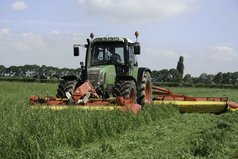How to make the best first cut of grass silage?
|
How successfully do you want to produce quality roughage? These five practical management tips will guide you on how to collect the best possible first cut of grass silage and stay successful for the remainder of the harvest:
1. Determine your cutting strategy for the season Now is the time to determine your strategy for the season, before you start cutting. Are you going to apply a four or five cut strategy? Danish trials show that choosing four or five cuts doesn’t influence the total yield, but it does make a difference to the quality you harvest. Applying a five cut strategy results in more raw protein and higher energy levels harvested per hectare. |
|
|
2. Choose the optimal time Choose the optimal time! The ideal time to harvest is when there is approximately 3.5 tonnes of grass on the field. For perennial ryegrass, this when the grass is 30-35 cm tall, while for NutriFibre (soft leafed tall fescue) this is 35-40 cm. If the crop becomes heavier, the lower parts of the plants will die resulting in mould. This situation should be avoided, since it leads to loss of quality of the forage.
|
 |
|
3. Cut before the grass starts heading Another indication for the optimal timing of your first cut is the heading date. As soon as heading starts to become apparent, the quality of the crop begins to decline. Grass mixtures containing late types of varieties head later. This allows a longer growth period before quality loss sets in. Cutting before heading becomes visible will give you the highest quality forage. However, after the first cut, heading is no longer a good indicator for NutriFibre, as heading will not be apparent in the following cuts.
|
|
|
4. Don’t cut the grass too short Would you also like to have fast regrowth? The key to optimal later cuts is not to cut the grass too short above soil level. Perennial ryegrass can be cut to 4-6 cm from soil level: NutriFibre should be left at least 7-8 cm. Making the right decisions for the second cut now means you can harvest maximum levels of quality roughage later. Apply fertilizer and slurry right after the harvest to encourage optimal regrowth and avoid burning and contaminating the grass. |
|
|
5.Dry matter content matters To obtain the best quality silage, the ideal dry matter content is 30% to 40%. Keep in mind that the drying time of the grass may vary. NutriFibre dries quicker than perennial ryegrass, so it will be ready for processing sooner. At this point, silage is easier to press in the stack and enables a faster silaging process. |

